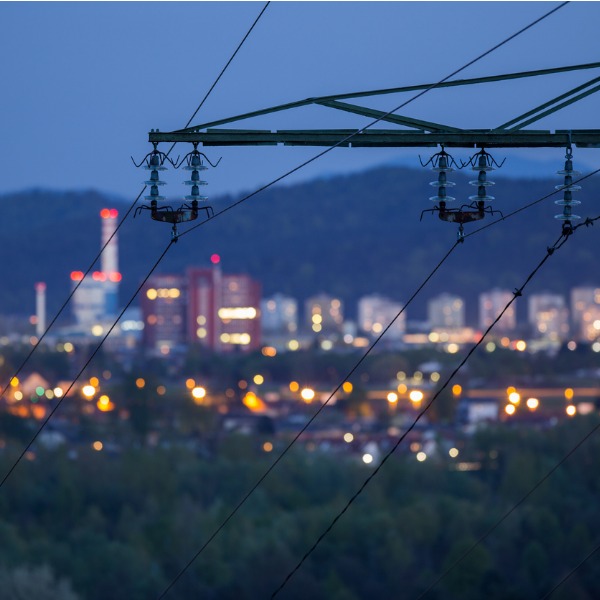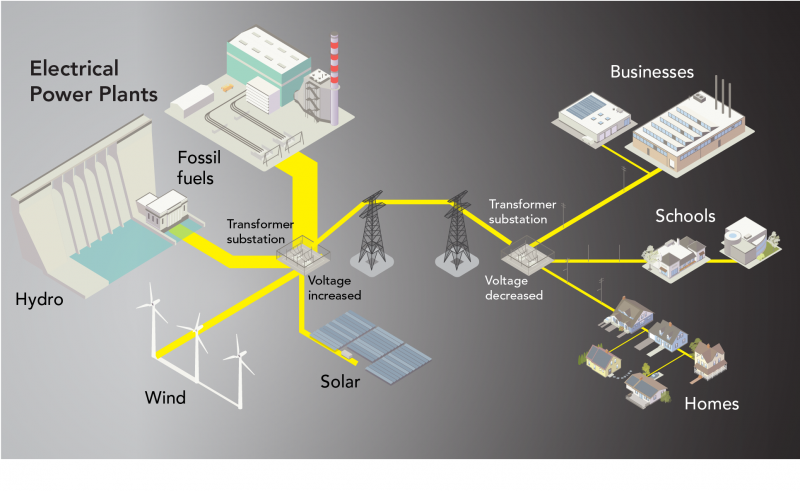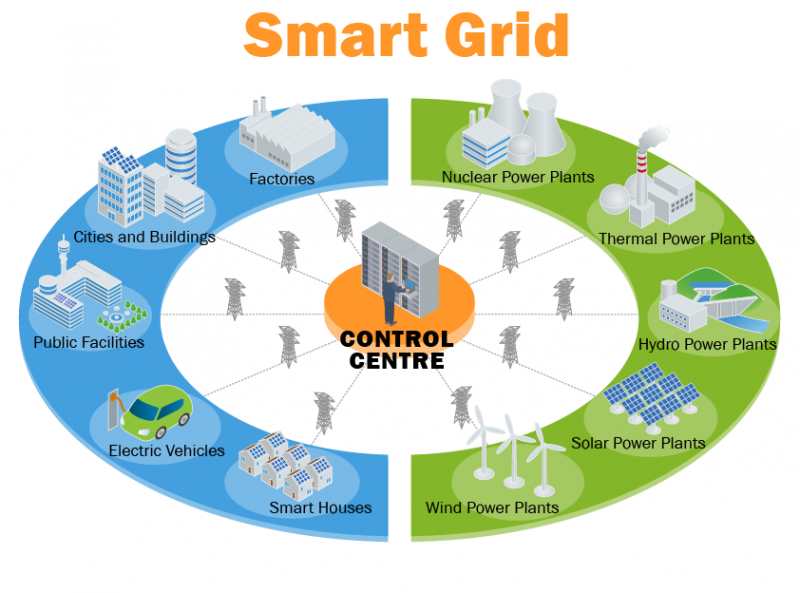Understanding Electricity Supply and Demand

City at night with transmission lines (Urban78, iStockphoto)

City at night with transmission lines (Urban78, iStockphoto)
How does this align with my curriculum?
Electricity demand changes constantly. Suppliers need to generate more electrical energy when demand is high, and less when demand is low.
How many ways do you use electricity every day? You turn on the lights. You might charge your phone. Maybe you cook some food. You might even travel in an electric car or train!
Electrical energy is an important part of most people’s lives. But how do electricity suppliers make sure there’s enough for everyone? Let’s learn more about how supply meets demand.
What Is Electricity Supply?
Where does electricity come from? And how does it move around? These are key questions for understanding electricity supply.
Electrical power plants generate electricity. Then, it travels through the electrical grid. This complex network delivers electricity to homes, schools and businesses.
Large transmission lines carry electricity. They run from power plants to transformer substations. These facilities increase the voltage so that the electricity can travel long distances. Near homes other transformer substations decrease the voltage. Smaller distribution lines deliver lower-voltage electricity to users.

Illustration - Text Version
Electrical power plants using energy from hydro, fossil fuels, wind and solar send electricity via transformer substations to businesses, schools and homes.
Electricity supply has to match demand. But demand changes over the course of a day. Suppliers need to generate more electrical energy when demand is high. And they need to generate less when demand is low.
In other words, suppliers need to avoid undersupply and oversupply. Managing the ups and downs of electricity generation isn’t easy!
Undersupply happens when suppliers don’t generate enough electricity. It can cause problems like blackouts and brownouts.
Oversupply happens when suppliers generate too much electricity. Sometimes, they can sell this extra energy. Otherwise, it goes to waste. That’s because electricity can’t be stored. It can only be converted to other forms of energy. And that can be converted into electrical energy when needed. For example, giant batteries can change electricity into chemical energy and back.
Suppliers generate electricity using different energy resources. Some resources are renewable. Others are non-renewable.
Renewable resources include wind, sunlight and moving water. Electrical energy generated from sunlight is called solar power. Electrical energy generated from moving water is called hydroelectricity.
Non-renewable resources include nuclear power and fossil fuels. Fossil fuels release a lot of greenhouse gases when they are burned.
Renewable resources provide the cleanest electricity. But many of them are intermittent. That means they don’t work all the time. The wind doesn’t always blow. The Sun doesn’t always shine.
What Is Electricity Demand?
Demand for electricity varies. It can change over the course of a day, a week or a year. People use a lot of electricity in the morning and evening. They use less when they’re at school or work. They also use less on the weekend. Air conditioners run a lot more in the summer. Heaters run a lot more in the winter. Both of these run a lot less in the spring and fall.
Suppliers normally measure demand in 15-minute periods.
Peak demand describes the periods with the highest electricity use. This normally happens in the morning and evening. When they get up, people use a lot of electrical energy. They turn on lights. They turn on the heat or air conditioning. They take showers. They cook breakfast. People also use a lot of electricity when they get home from school or work. They turn the lights back on. They turn on the heat or air conditioning. They cook supper. They turn on the TV or other devices.
Energy usage graphs can help you understand electricity demand. The big upward spikes show peak demand.

Did you know?
Using electricity during peak times can be much more expensive. It can make up between 30% and 70% of your home’s electrical bill!
How do electricity systems balance supply and demand?
Suppliers predict how much electrical energy they need to generate at a certain time. Historical records let them see what the demand was at similar times in the past. Advanced computer models help interpret the information.
The lights in your home may not use much energy. But there could be thousands of people turning on their lights at the exact same time. That can add up to a huge electricity demand! All that electrical power needs to come from somewhere.
Did you know?
Smart Grids can make electrical systems more efficient. They automatically react to local changes in energy use.

Of course, suppliers can generate more electricity when demand is high. And when demand drops, they can go back to generating less. But generating more electricity often means using more fossil fuels. You can’t just turn up the Sun or the wind whenever you want!
But what if you could store extra energy generated at off-peak times? Energy storage technologies make this possible. The energy can be released when demand goes up. This makes the electricity system much more flexible. It also avoids using non-renewable resources when demand is high!
Learn More
Energy 101: Electricity Generation (2011)
A video (5:18 min.) from EnergyNowNews gives a comprehensive overview of how electricity is generated -- from the source to using it in your home or school.
The Smart Grid Explained (2011)
Video (3:00 min.) from EPCEenergyeducation explaining how Smart Grids work and how they are a beneficial way to manage the movement of electricity.
Why Will Energy Storage Lead the Way to a Clean Energy Future? (2018)
Infographic from Saft summarizing energy demand and how energy storage could help facilitate the shift from non-renewable to renewable energy resources for energy generation.
References
IncSys. (n.d.). What is a system operator?
Rinkesh. (n.d.). What are different sources of energy? Conserve Energy Future.
Phongchit, N. (2017, March 23). What is peak demand? Setra Systems.
U.S. Energy Information Administration. (2018, August 31). How electricity is delivered to consumers.
World Nuclear Association. (2019, May). Electricity and energy storage.